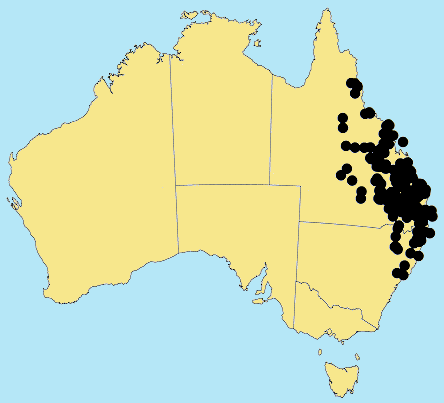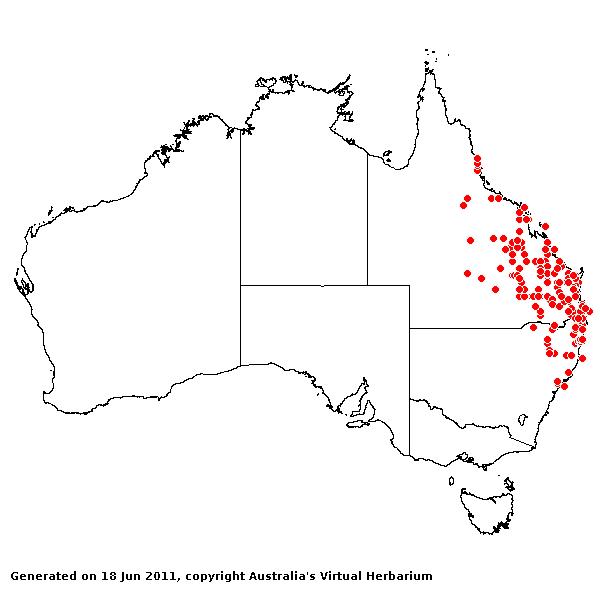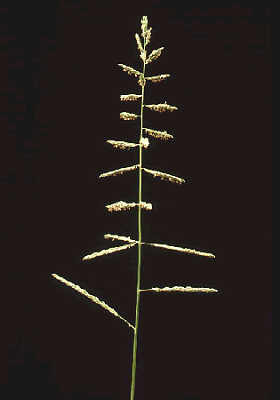Urochloa foliosa (R. Br.) R.D.
Webster. Australian Paniceae (Poac.): 236: (1987).
Classification. (GPWG 2001) : Subfamily Panicoideae. Paniceae.
Basionym and/or
Replacement Name: Panicum
foliosum R. Br., Prodr. 191 (1810).
Type of Basionym or
Protologue Information: HT: R. Brown 6110, Australia: Queensland:
Keppel Bay (BM).
Recent synonyms:
Brachiaria foliosa.
Key references
(books and floras): [1810]. R.Brown, Prodromus (191 as Panicum
foliosum), [1878] G.Bentham, Flora Australiensis 7 (481 as Panicum
foliosum), [2002] D.Sharp & B.K.Simon, AusGrass, Grasses of
Australia (as Brachiaria), [2008] S.W.L.Jacobs, R.D.B.Walley &
D.J.B.Wheeler, Grasses of New South Wales (394).
Illustrations:
[1984] N.T.Burbidge. rev. S.W.L.Jacobs, Australian Grasses (77 as Brachiaria foliosa), [2008]
S.W.L.Jacobs, R.D.B.Whalley & D.J.B.Wheeler, Grasses of New South Wales,
4th edn (394).
Habit. Perennial. Rhizomes present. Stolons absent. Culms geniculately
ascending or decumbent, 25–90 cm tall, 3–6 -noded. Mid-culm internodes glabrous
or pubescent or hirsute. Mid-culm nodes pubescent or bearded. Leaf-sheaths
hairy. Ligule a fringe of hairs. Leaf-blades lanceolate or oblong, 4–19 cm
long, 4–22 mm wide. Leaf-blade surface indumented.
Inflorescence.
Inflorescence compound, a panicle of racemes. Racemes 5–10, 2.5–9 cm long, 3–5
mm wide. Central inflorescence axis 3–18 cm long.
Spikelets.
Spikelets pedicelled. Fertile spikelets 2-flowered, the lower floret barren
(rarely male), the upper fertile, comprising 1 basal sterile florets,
comprising 1 fertile floret(s), without rachilla extension, lanceolate or
elliptic, dorsally compressed, 4.5–6.5 mm long. Rhachilla internodes elongated
between glumes and elongated below proximal fertile floret.
Glumes. Glumes
dissimilar, thinner than fertile lemma. Lower glume ovate, membranous, without
keels, 7–11 -nerved. Lower glume surface indumented. Upper glume elliptic,
4.5–6.2 mm long, membranous, without keels, 7–9 -nerved. Upper glume surface
indumented. Upper glume apex muticous. Florets. Basal sterile florets 1,
barren, with palea. Lemma of lower sterile floret 100 % of length of spikelet,
membranous, 5 -nerved.
Fertile lemma 3.3–4.1
mm long, without keel. Lemma apex mucronate. Palea without keels.
Continental
Distribution: Australasia.
Australian
Distribution: Queensland, New South Wales.
Queensland:
Burke, Burnett, Cook, Darling Downs, Leichhardt, Maranoa, Mitchell, Moreton,
North Kennedy, Port Curtis, South Kennedy, Warrego, Wide Bay. New South
Wales: North Coast, North-Western Slopes, North-Western Plains.
Notes.
Diagnostic features include spikelet length, spreading primary branches, the
distinct constriction at the base of the upper glume, and the rounded pedicel
apex. The pedicel apex is similar to that found in Paspalum. Specimens
from the western part of its distribution possess much narrower leaf blades. A
typical example of this variation was collected at Bowen Downs by G.R. Lee
(BRI). Brachiaria foliosa is similar to the introduced species, U.
texana.
In tropical heaths,
tropical and subtropical rain forests, tropical and subtropical wet sclerophyll
forests, dry sclerophyll forests, Brigalow forests, tropical and subtropical
sub-humid woodlands, and semi-arid shrub woodlands. Flowers throughout the year
but mostly Nov.-June.




